CHCECE012: Education and Care Service Sustainability Report
VerifiedAdded on 2022/10/06
|6
|1439
|49
Report
AI Summary
This report, created for the CHCECE012 unit, focuses on supporting children's connection with the world within an education and care service setting. It addresses the definition of sustainable practice, identifies ways children can participate in sustainability, and explores opportunities to introduce and improve sustainability concepts. The report outlines strategies for providing children with responsible outdoor space experiences, considering differing abilities, and includes potential challenges and considerations. It emphasizes activities such as water conservation, recycling programs, and discussions about environmental issues. The report concludes with an evaluation of the proposed strategies and their potential impact on fostering environmental responsibility in young children. The assignment also considers the importance of creating an inclusive environment where children of all abilities can participate and connect with their surroundings.
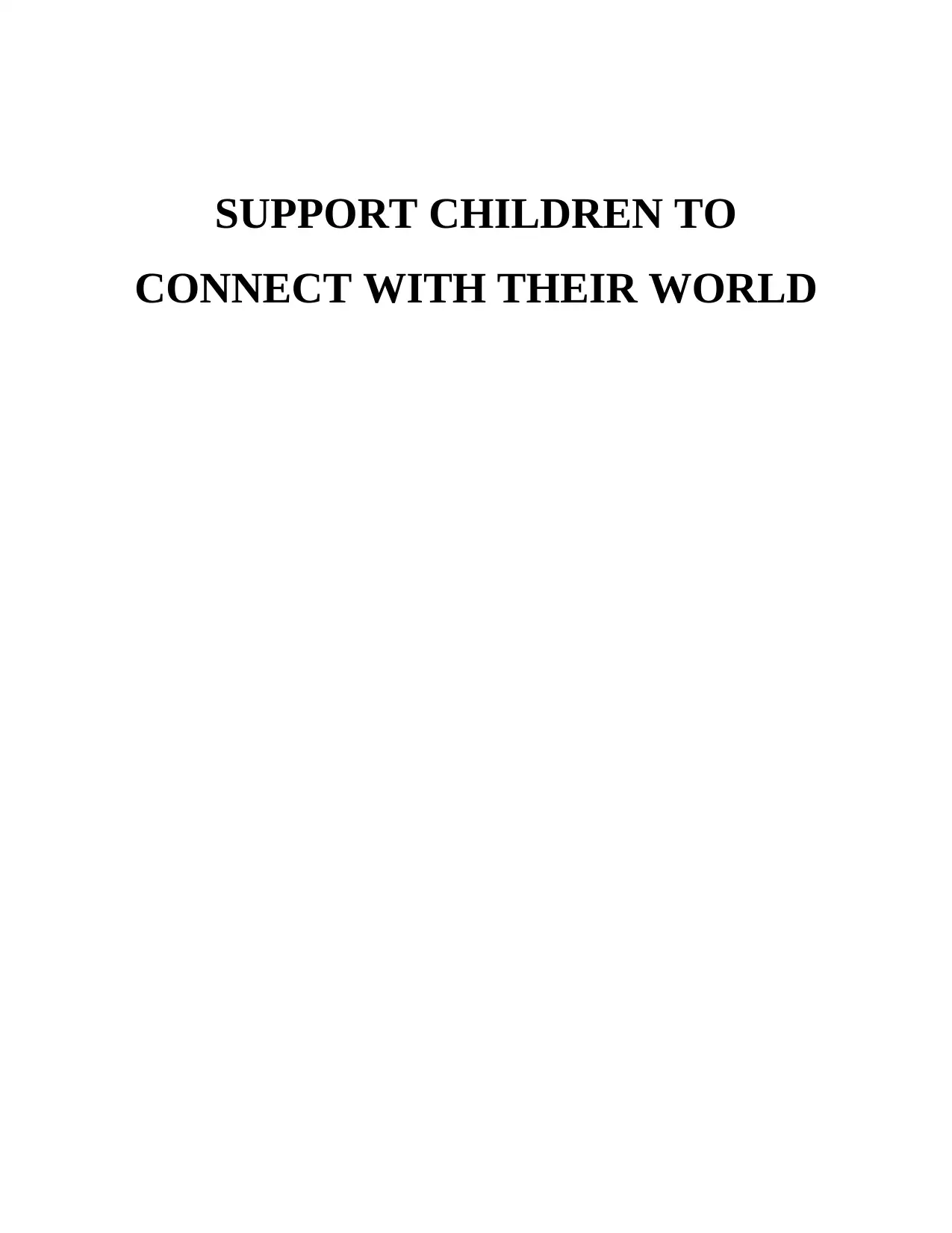
SUPPORT CHILDREN TO
CONNECT WITH THEIR WORLD
CONNECT WITH THEIR WORLD
Paraphrase This Document
Need a fresh take? Get an instant paraphrase of this document with our AI Paraphraser
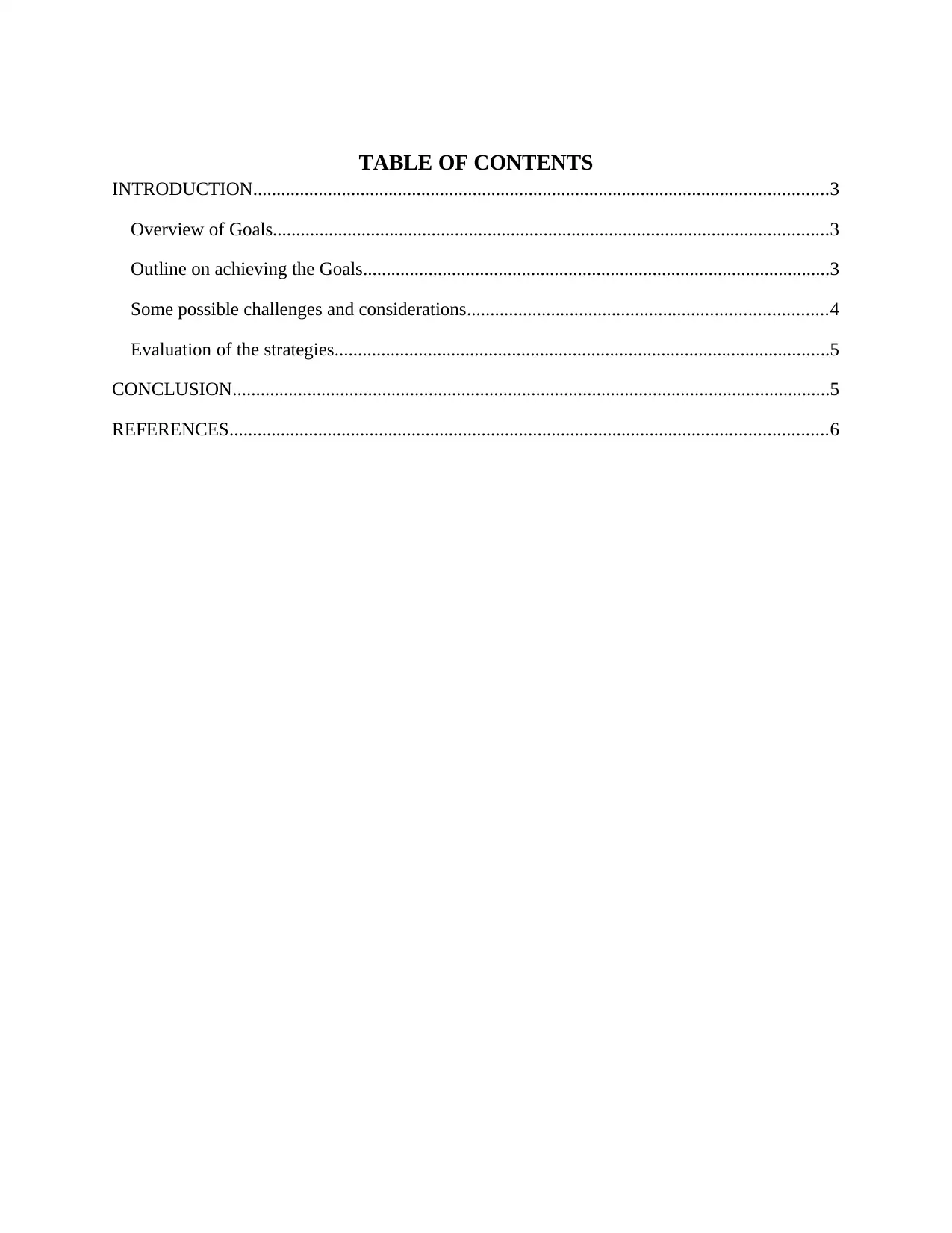
TABLE OF CONTENTS
INTRODUCTION...........................................................................................................................3
Overview of Goals.......................................................................................................................3
Outline on achieving the Goals....................................................................................................3
Some possible challenges and considerations.............................................................................4
Evaluation of the strategies..........................................................................................................5
CONCLUSION................................................................................................................................5
REFERENCES................................................................................................................................6
INTRODUCTION...........................................................................................................................3
Overview of Goals.......................................................................................................................3
Outline on achieving the Goals....................................................................................................3
Some possible challenges and considerations.............................................................................4
Evaluation of the strategies..........................................................................................................5
CONCLUSION................................................................................................................................5
REFERENCES................................................................................................................................6
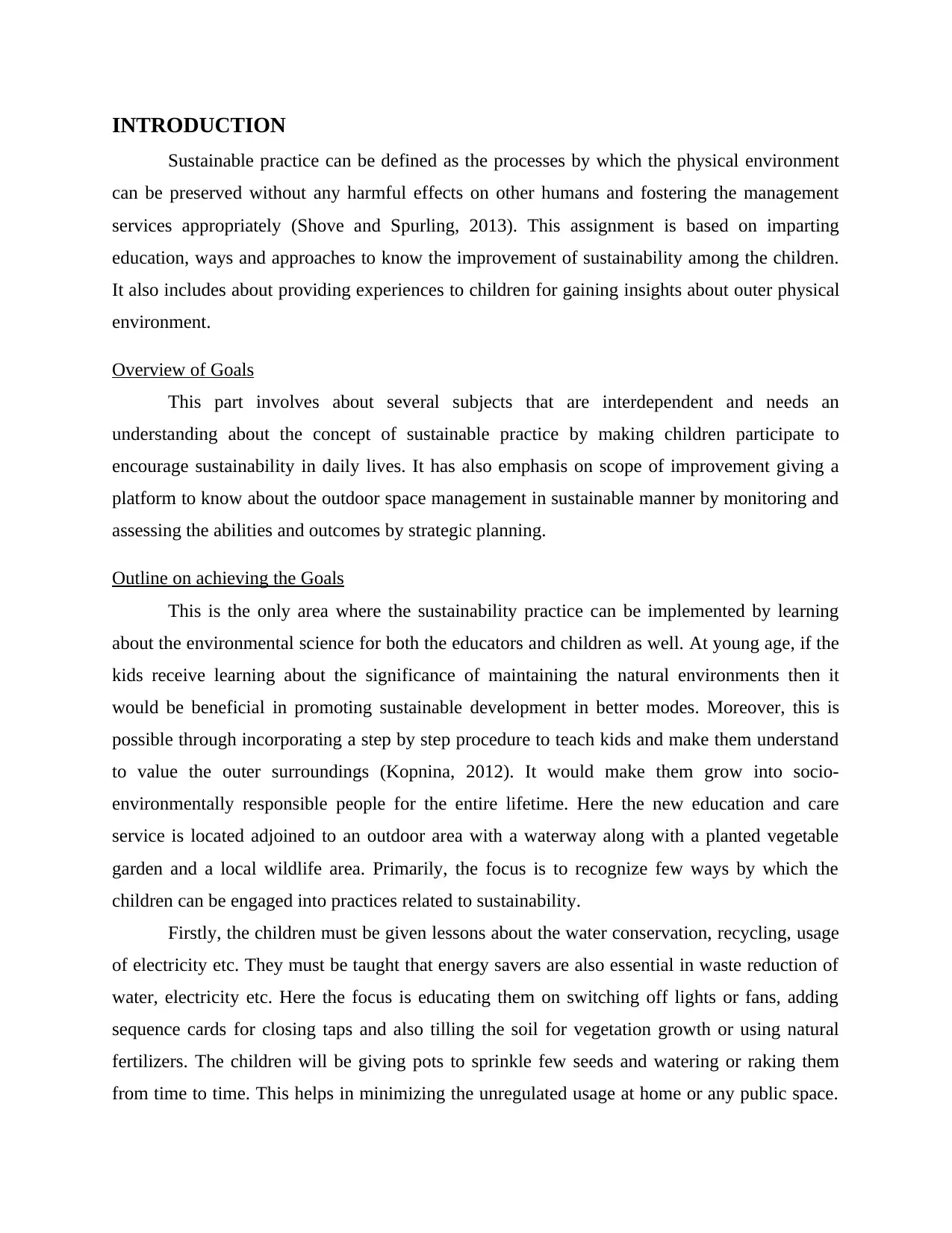
INTRODUCTION
Sustainable practice can be defined as the processes by which the physical environment
can be preserved without any harmful effects on other humans and fostering the management
services appropriately (Shove and Spurling, 2013). This assignment is based on imparting
education, ways and approaches to know the improvement of sustainability among the children.
It also includes about providing experiences to children for gaining insights about outer physical
environment.
Overview of Goals
This part involves about several subjects that are interdependent and needs an
understanding about the concept of sustainable practice by making children participate to
encourage sustainability in daily lives. It has also emphasis on scope of improvement giving a
platform to know about the outdoor space management in sustainable manner by monitoring and
assessing the abilities and outcomes by strategic planning.
Outline on achieving the Goals
This is the only area where the sustainability practice can be implemented by learning
about the environmental science for both the educators and children as well. At young age, if the
kids receive learning about the significance of maintaining the natural environments then it
would be beneficial in promoting sustainable development in better modes. Moreover, this is
possible through incorporating a step by step procedure to teach kids and make them understand
to value the outer surroundings (Kopnina, 2012). It would make them grow into socio-
environmentally responsible people for the entire lifetime. Here the new education and care
service is located adjoined to an outdoor area with a waterway along with a planted vegetable
garden and a local wildlife area. Primarily, the focus is to recognize few ways by which the
children can be engaged into practices related to sustainability.
Firstly, the children must be given lessons about the water conservation, recycling, usage
of electricity etc. They must be taught that energy savers are also essential in waste reduction of
water, electricity etc. Here the focus is educating them on switching off lights or fans, adding
sequence cards for closing taps and also tilling the soil for vegetation growth or using natural
fertilizers. The children will be giving pots to sprinkle few seeds and watering or raking them
from time to time. This helps in minimizing the unregulated usage at home or any public space.
Sustainable practice can be defined as the processes by which the physical environment
can be preserved without any harmful effects on other humans and fostering the management
services appropriately (Shove and Spurling, 2013). This assignment is based on imparting
education, ways and approaches to know the improvement of sustainability among the children.
It also includes about providing experiences to children for gaining insights about outer physical
environment.
Overview of Goals
This part involves about several subjects that are interdependent and needs an
understanding about the concept of sustainable practice by making children participate to
encourage sustainability in daily lives. It has also emphasis on scope of improvement giving a
platform to know about the outdoor space management in sustainable manner by monitoring and
assessing the abilities and outcomes by strategic planning.
Outline on achieving the Goals
This is the only area where the sustainability practice can be implemented by learning
about the environmental science for both the educators and children as well. At young age, if the
kids receive learning about the significance of maintaining the natural environments then it
would be beneficial in promoting sustainable development in better modes. Moreover, this is
possible through incorporating a step by step procedure to teach kids and make them understand
to value the outer surroundings (Kopnina, 2012). It would make them grow into socio-
environmentally responsible people for the entire lifetime. Here the new education and care
service is located adjoined to an outdoor area with a waterway along with a planted vegetable
garden and a local wildlife area. Primarily, the focus is to recognize few ways by which the
children can be engaged into practices related to sustainability.
Firstly, the children must be given lessons about the water conservation, recycling, usage
of electricity etc. They must be taught that energy savers are also essential in waste reduction of
water, electricity etc. Here the focus is educating them on switching off lights or fans, adding
sequence cards for closing taps and also tilling the soil for vegetation growth or using natural
fertilizers. The children will be giving pots to sprinkle few seeds and watering or raking them
from time to time. This helps in minimizing the unregulated usage at home or any public space.
⊘ This is a preview!⊘
Do you want full access?
Subscribe today to unlock all pages.

Trusted by 1+ million students worldwide
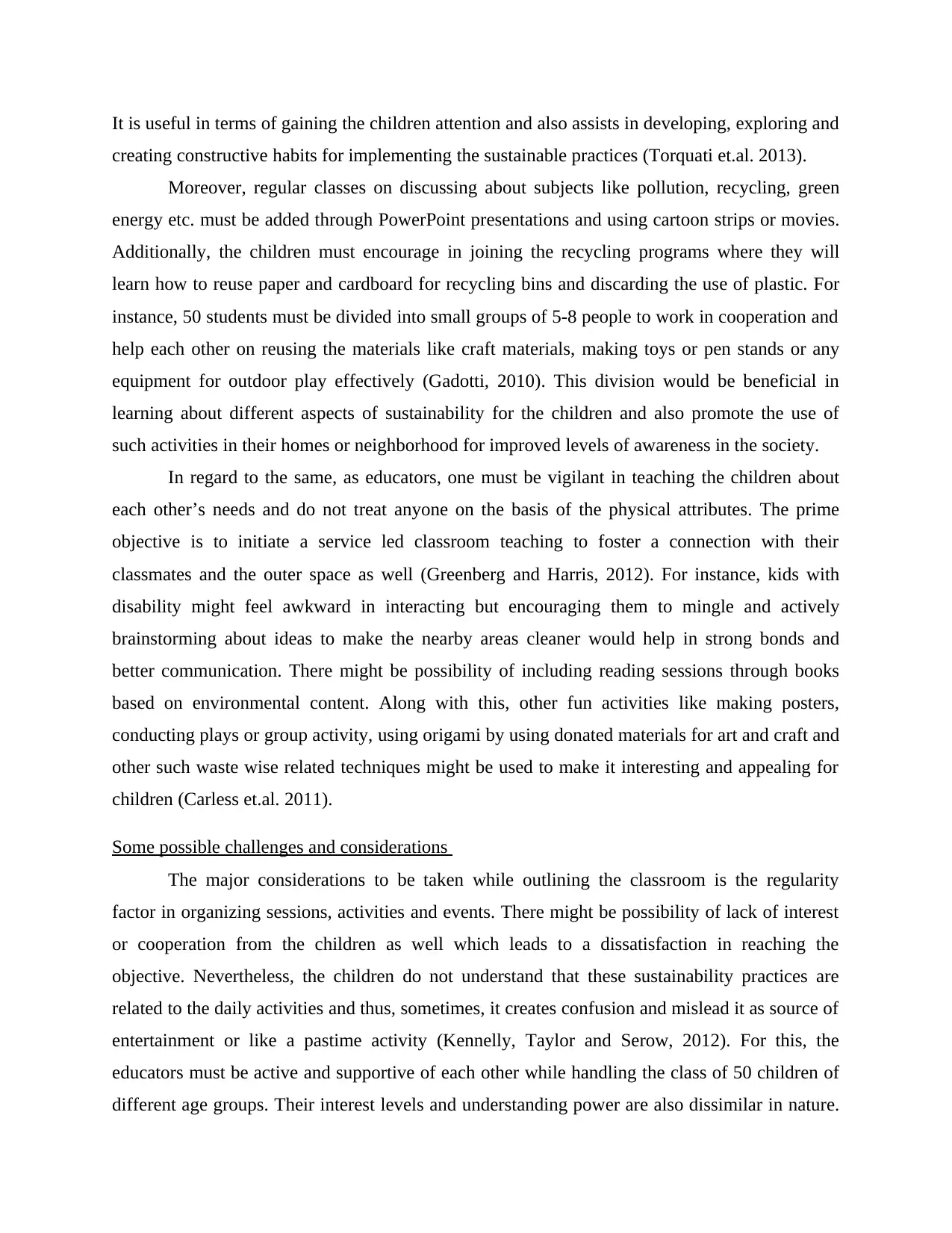
It is useful in terms of gaining the children attention and also assists in developing, exploring and
creating constructive habits for implementing the sustainable practices (Torquati et.al. 2013).
Moreover, regular classes on discussing about subjects like pollution, recycling, green
energy etc. must be added through PowerPoint presentations and using cartoon strips or movies.
Additionally, the children must encourage in joining the recycling programs where they will
learn how to reuse paper and cardboard for recycling bins and discarding the use of plastic. For
instance, 50 students must be divided into small groups of 5-8 people to work in cooperation and
help each other on reusing the materials like craft materials, making toys or pen stands or any
equipment for outdoor play effectively (Gadotti, 2010). This division would be beneficial in
learning about different aspects of sustainability for the children and also promote the use of
such activities in their homes or neighborhood for improved levels of awareness in the society.
In regard to the same, as educators, one must be vigilant in teaching the children about
each other’s needs and do not treat anyone on the basis of the physical attributes. The prime
objective is to initiate a service led classroom teaching to foster a connection with their
classmates and the outer space as well (Greenberg and Harris, 2012). For instance, kids with
disability might feel awkward in interacting but encouraging them to mingle and actively
brainstorming about ideas to make the nearby areas cleaner would help in strong bonds and
better communication. There might be possibility of including reading sessions through books
based on environmental content. Along with this, other fun activities like making posters,
conducting plays or group activity, using origami by using donated materials for art and craft and
other such waste wise related techniques might be used to make it interesting and appealing for
children (Carless et.al. 2011).
Some possible challenges and considerations
The major considerations to be taken while outlining the classroom is the regularity
factor in organizing sessions, activities and events. There might be possibility of lack of interest
or cooperation from the children as well which leads to a dissatisfaction in reaching the
objective. Nevertheless, the children do not understand that these sustainability practices are
related to the daily activities and thus, sometimes, it creates confusion and mislead it as source of
entertainment or like a pastime activity (Kennelly, Taylor and Serow, 2012). For this, the
educators must be active and supportive of each other while handling the class of 50 children of
different age groups. Their interest levels and understanding power are also dissimilar in nature.
creating constructive habits for implementing the sustainable practices (Torquati et.al. 2013).
Moreover, regular classes on discussing about subjects like pollution, recycling, green
energy etc. must be added through PowerPoint presentations and using cartoon strips or movies.
Additionally, the children must encourage in joining the recycling programs where they will
learn how to reuse paper and cardboard for recycling bins and discarding the use of plastic. For
instance, 50 students must be divided into small groups of 5-8 people to work in cooperation and
help each other on reusing the materials like craft materials, making toys or pen stands or any
equipment for outdoor play effectively (Gadotti, 2010). This division would be beneficial in
learning about different aspects of sustainability for the children and also promote the use of
such activities in their homes or neighborhood for improved levels of awareness in the society.
In regard to the same, as educators, one must be vigilant in teaching the children about
each other’s needs and do not treat anyone on the basis of the physical attributes. The prime
objective is to initiate a service led classroom teaching to foster a connection with their
classmates and the outer space as well (Greenberg and Harris, 2012). For instance, kids with
disability might feel awkward in interacting but encouraging them to mingle and actively
brainstorming about ideas to make the nearby areas cleaner would help in strong bonds and
better communication. There might be possibility of including reading sessions through books
based on environmental content. Along with this, other fun activities like making posters,
conducting plays or group activity, using origami by using donated materials for art and craft and
other such waste wise related techniques might be used to make it interesting and appealing for
children (Carless et.al. 2011).
Some possible challenges and considerations
The major considerations to be taken while outlining the classroom is the regularity
factor in organizing sessions, activities and events. There might be possibility of lack of interest
or cooperation from the children as well which leads to a dissatisfaction in reaching the
objective. Nevertheless, the children do not understand that these sustainability practices are
related to the daily activities and thus, sometimes, it creates confusion and mislead it as source of
entertainment or like a pastime activity (Kennelly, Taylor and Serow, 2012). For this, the
educators must be active and supportive of each other while handling the class of 50 children of
different age groups. Their interest levels and understanding power are also dissimilar in nature.
Paraphrase This Document
Need a fresh take? Get an instant paraphrase of this document with our AI Paraphraser
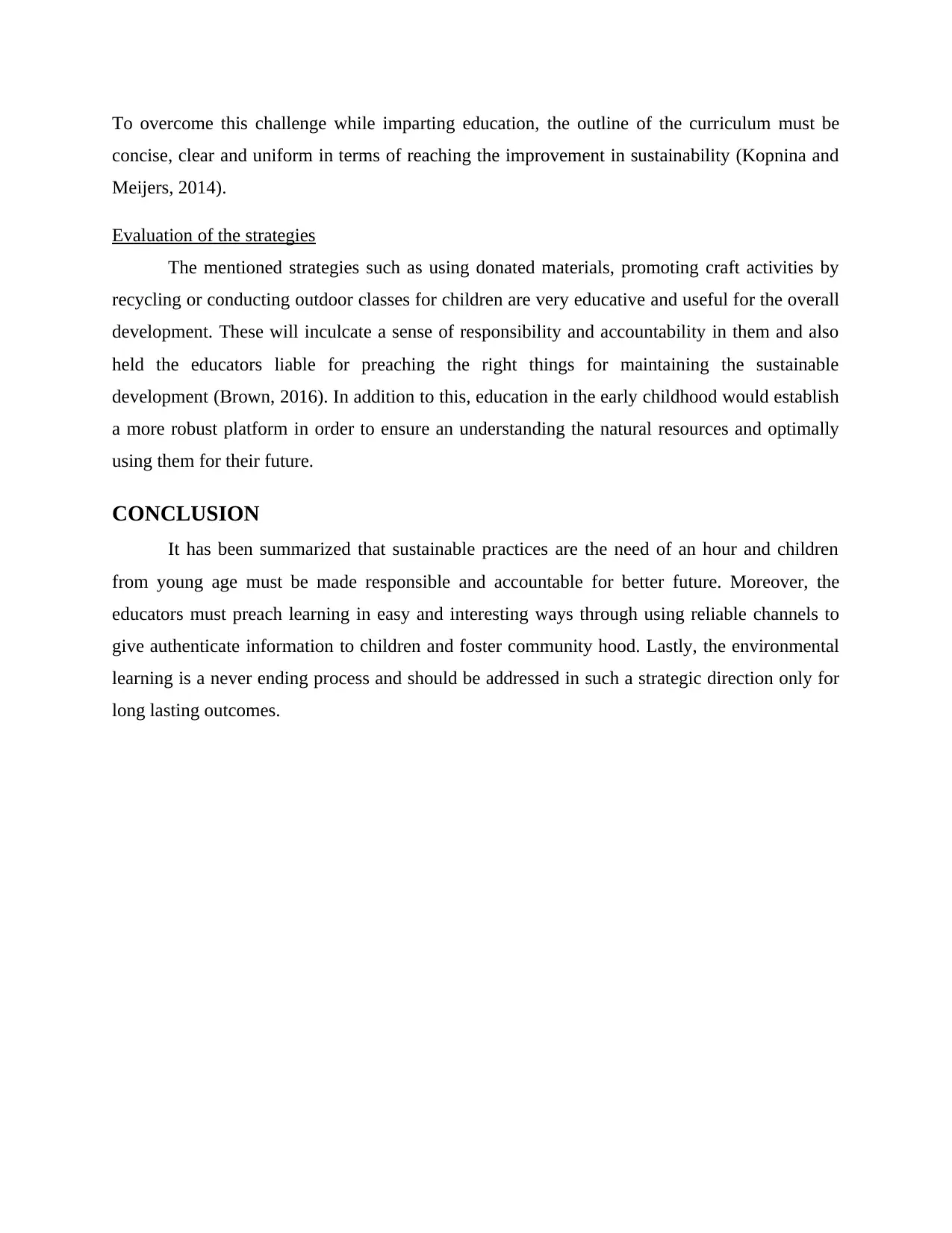
To overcome this challenge while imparting education, the outline of the curriculum must be
concise, clear and uniform in terms of reaching the improvement in sustainability (Kopnina and
Meijers, 2014).
Evaluation of the strategies
The mentioned strategies such as using donated materials, promoting craft activities by
recycling or conducting outdoor classes for children are very educative and useful for the overall
development. These will inculcate a sense of responsibility and accountability in them and also
held the educators liable for preaching the right things for maintaining the sustainable
development (Brown, 2016). In addition to this, education in the early childhood would establish
a more robust platform in order to ensure an understanding the natural resources and optimally
using them for their future.
CONCLUSION
It has been summarized that sustainable practices are the need of an hour and children
from young age must be made responsible and accountable for better future. Moreover, the
educators must preach learning in easy and interesting ways through using reliable channels to
give authenticate information to children and foster community hood. Lastly, the environmental
learning is a never ending process and should be addressed in such a strategic direction only for
long lasting outcomes.
concise, clear and uniform in terms of reaching the improvement in sustainability (Kopnina and
Meijers, 2014).
Evaluation of the strategies
The mentioned strategies such as using donated materials, promoting craft activities by
recycling or conducting outdoor classes for children are very educative and useful for the overall
development. These will inculcate a sense of responsibility and accountability in them and also
held the educators liable for preaching the right things for maintaining the sustainable
development (Brown, 2016). In addition to this, education in the early childhood would establish
a more robust platform in order to ensure an understanding the natural resources and optimally
using them for their future.
CONCLUSION
It has been summarized that sustainable practices are the need of an hour and children
from young age must be made responsible and accountable for better future. Moreover, the
educators must preach learning in easy and interesting ways through using reliable channels to
give authenticate information to children and foster community hood. Lastly, the environmental
learning is a never ending process and should be addressed in such a strategic direction only for
long lasting outcomes.
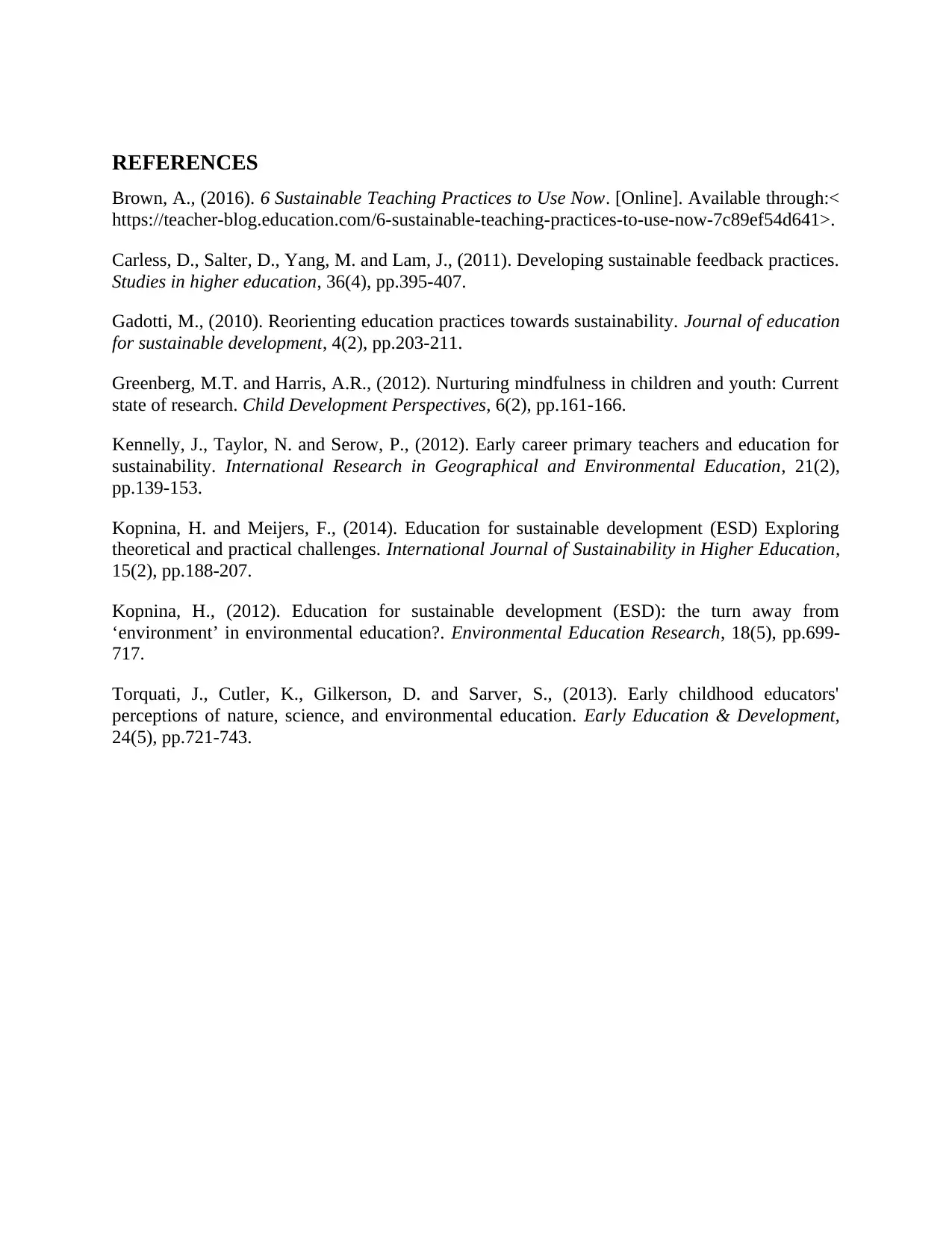
REFERENCES
Brown, A., (2016). 6 Sustainable Teaching Practices to Use Now. [Online]. Available through:<
https://teacher-blog.education.com/6-sustainable-teaching-practices-to-use-now-7c89ef54d641>.
Carless, D., Salter, D., Yang, M. and Lam, J., (2011). Developing sustainable feedback practices.
Studies in higher education, 36(4), pp.395-407.
Gadotti, M., (2010). Reorienting education practices towards sustainability. Journal of education
for sustainable development, 4(2), pp.203-211.
Greenberg, M.T. and Harris, A.R., (2012). Nurturing mindfulness in children and youth: Current
state of research. Child Development Perspectives, 6(2), pp.161-166.
Kennelly, J., Taylor, N. and Serow, P., (2012). Early career primary teachers and education for
sustainability. International Research in Geographical and Environmental Education, 21(2),
pp.139-153.
Kopnina, H. and Meijers, F., (2014). Education for sustainable development (ESD) Exploring
theoretical and practical challenges. International Journal of Sustainability in Higher Education,
15(2), pp.188-207.
Kopnina, H., (2012). Education for sustainable development (ESD): the turn away from
‘environment’ in environmental education?. Environmental Education Research, 18(5), pp.699-
717.
Torquati, J., Cutler, K., Gilkerson, D. and Sarver, S., (2013). Early childhood educators'
perceptions of nature, science, and environmental education. Early Education & Development,
24(5), pp.721-743.
Brown, A., (2016). 6 Sustainable Teaching Practices to Use Now. [Online]. Available through:<
https://teacher-blog.education.com/6-sustainable-teaching-practices-to-use-now-7c89ef54d641>.
Carless, D., Salter, D., Yang, M. and Lam, J., (2011). Developing sustainable feedback practices.
Studies in higher education, 36(4), pp.395-407.
Gadotti, M., (2010). Reorienting education practices towards sustainability. Journal of education
for sustainable development, 4(2), pp.203-211.
Greenberg, M.T. and Harris, A.R., (2012). Nurturing mindfulness in children and youth: Current
state of research. Child Development Perspectives, 6(2), pp.161-166.
Kennelly, J., Taylor, N. and Serow, P., (2012). Early career primary teachers and education for
sustainability. International Research in Geographical and Environmental Education, 21(2),
pp.139-153.
Kopnina, H. and Meijers, F., (2014). Education for sustainable development (ESD) Exploring
theoretical and practical challenges. International Journal of Sustainability in Higher Education,
15(2), pp.188-207.
Kopnina, H., (2012). Education for sustainable development (ESD): the turn away from
‘environment’ in environmental education?. Environmental Education Research, 18(5), pp.699-
717.
Torquati, J., Cutler, K., Gilkerson, D. and Sarver, S., (2013). Early childhood educators'
perceptions of nature, science, and environmental education. Early Education & Development,
24(5), pp.721-743.
⊘ This is a preview!⊘
Do you want full access?
Subscribe today to unlock all pages.

Trusted by 1+ million students worldwide
1 out of 6
Related Documents
Your All-in-One AI-Powered Toolkit for Academic Success.
+13062052269
info@desklib.com
Available 24*7 on WhatsApp / Email
![[object Object]](/_next/static/media/star-bottom.7253800d.svg)
Unlock your academic potential
Copyright © 2020–2025 A2Z Services. All Rights Reserved. Developed and managed by ZUCOL.





